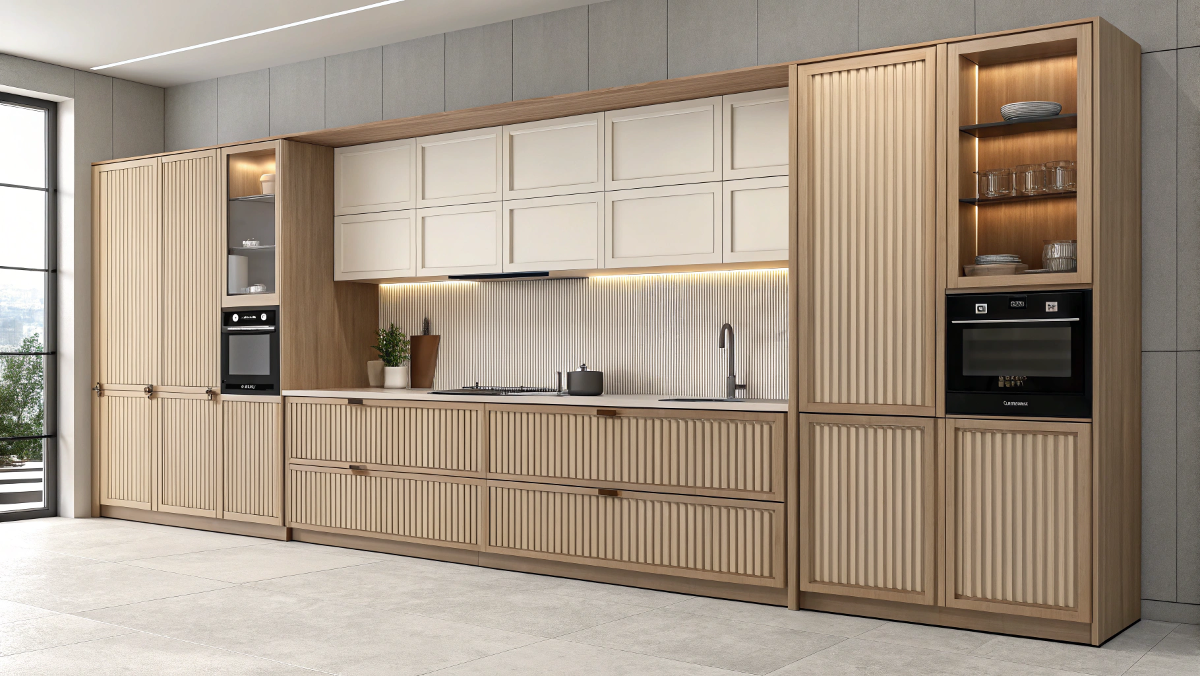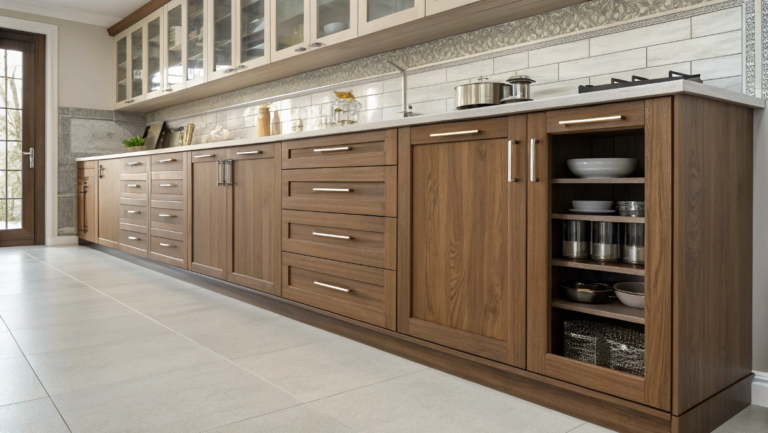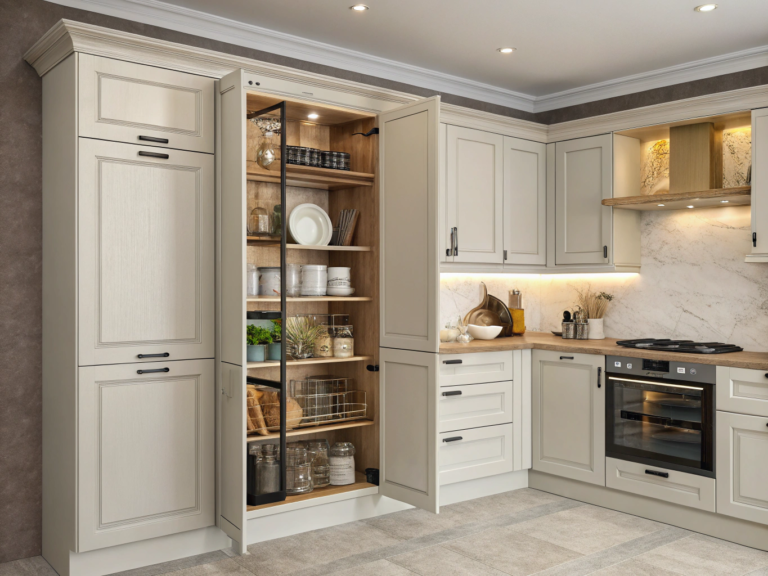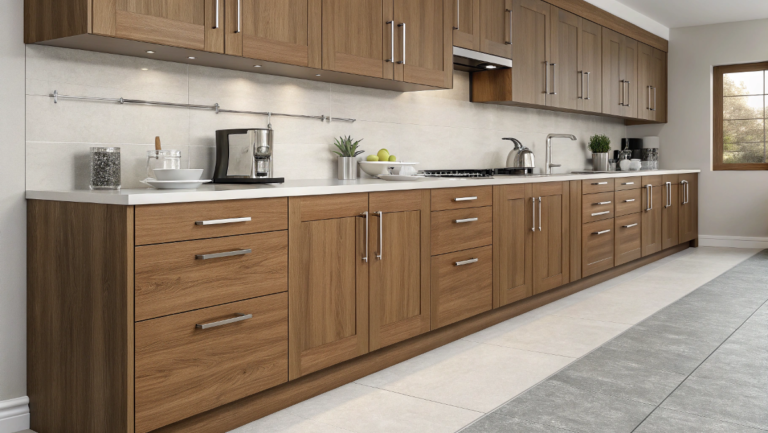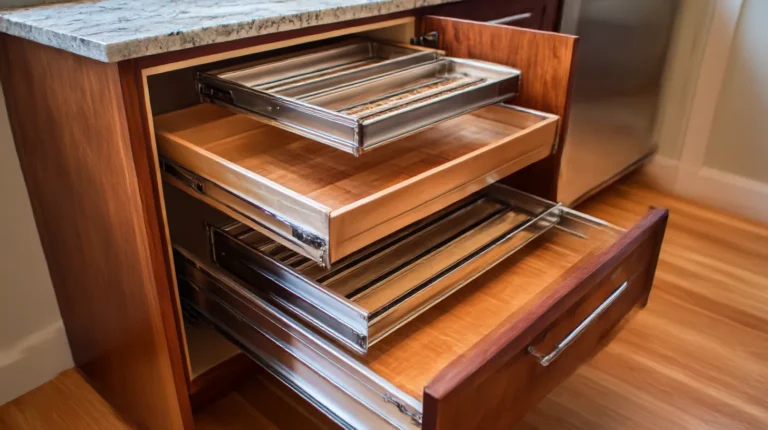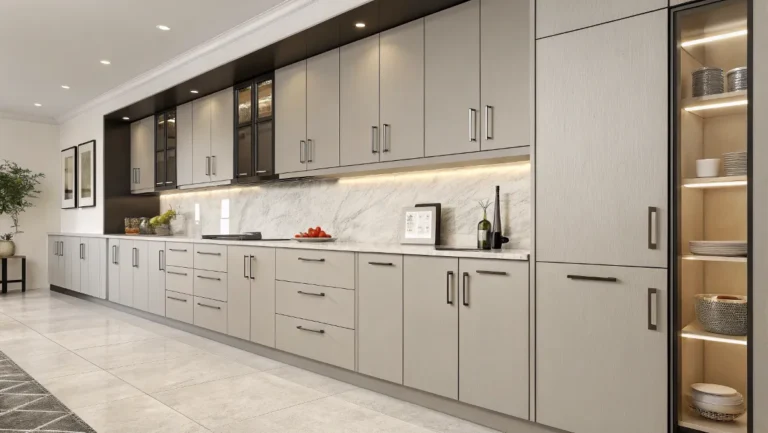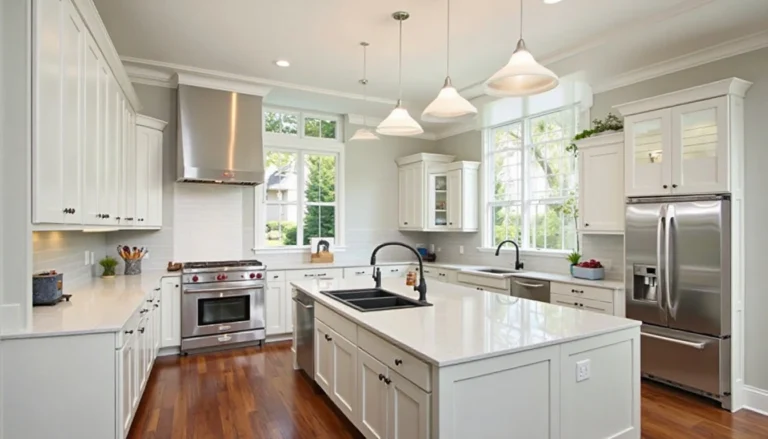fluted kitchen cabinets design ideas 2025
I still remember that Sunday afternoon in my grandma’s kitchen, the windows cracked open, the scent of oak dust curling into the air as I sanded down her worn cabinet doors. The grain came alive with every stroke, and for the first time, I saw that texture isn’t just pretty… it feels like home. That was the moment I realized: cabinets shouldn’t be flat, lifeless panels. They should speak.
Flash forward to today, and it’s like the design world finally caught up. Fluted kitchen cabinets, with their elegant, grooved detailing, are quietly taking over stylish homes and Instagram feeds alike. But this isn’t just a trend cooked up in a showroom. It’s part of a bigger shift toward kitchens that feel warm, layered, and deeply lived-in.
In this guide, I’ll walk you through what fluted cabinets really are, why they’ve become 2025’s texture obsession, how you can work them into your space (yes, even on a budget), and whether they’re the right fit for your home’s soul, not just its style.
What Are Fluted Cabinets? (And Why They’re Not Just Fancy Ridges)

Let’s demystify this: fluted cabinets aren’t some elite designer gimmick, they’re just regular cabinet fronts with vertical grooves carved or molded into them. Think of a wooden surface that’s been gently sculpted to create a rhythm. Not bumpy, not flashy. Just quietly textured, like the ripples on a calm lake or the pleats of your favorite linen curtains.
There are three terms you’ll see tossed around:
- Fluted: Broad, soft ridges with a rounded edge, classic, approachable.
- Reeded: Tighter, more pronounced grooves, feels a bit more structured and bold.
- Grooved: Often machine-cut with sharp lines, clean, modern, sometimes industrial.
They all fall under the same “textured cabinetry” umbrella, and honestly? It’s more about mood than labels. Fluted panels tend to feel warm and soft, like something you’d find in an old Parisian apartment. Reeded might nod more toward mid-century cocktail cabinets. Grooved? That’s your minimalist cousin who wears all black and knows what terrazzo is.
Here’s the part no one tells you: the difference isn’t just looks, it’s also how light plays across the surface. Those ridges catch shadows throughout the day. Morning sun makes them glow; evening light turns them into sculpture.
Quick Comparison Table
| Style | Look & Feel | Best For |
|---|---|---|
| Fluted | Soft, curved, elegant | Warm kitchens, vintage blends |
| Reeded | Tighter, bolder lines | Mid-century, modern glam |
| Grooved | Sharp, clean, linear | Minimalist, industrial vibes |
Are Fluted Cabinets Just a Trend?
Not exactly. While they’re trending right now, fluted textures have been around in architecture for centuries. What’s new is their comeback in kitchen design, especially as people crave spaces that feel hand-touched, not showroom-slick.
Why Fluted Cabinets Are Trending (and Why They Just Feel Right)
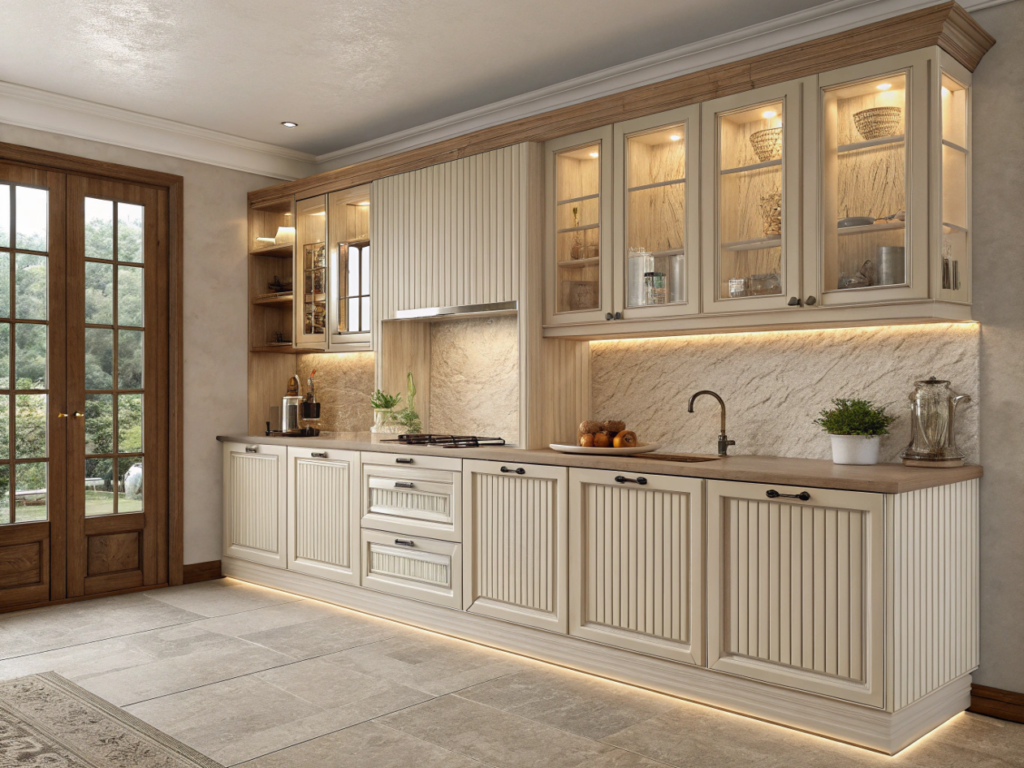
Some trends shout. This one whispers. Fluted cabinetry is quietly replacing flat, glossy surfaces in homes that want to feel… lived in. And maybe that’s no surprise, after years of sterile minimalism, people are craving a bit of soul in their kitchens.
Here’s what’s really behind the rise of fluted cabinets:
1. Texture Tells a Story
Flat-front cabinets can feel a little “mass-manufactured.” Fluted panels, with their grooves and shadows, add depth, visually and emotionally. It’s like giving your kitchen walls a subtle pulse.
2. They Hide the Mess (Bless Them)
Let’s be honest: kitchens are messy. Those tiny grooves? They’re surprisingly good at disguising fingerprints, splashes, and the smudge from that coffee you spilled and pretended didn’t happen. Fluted cabinets offer elegance with built-in forgiveness.
3. They Work with Everything
Seriously, from Scandinavian light woods to moody, jewel-toned palettes. Want brass handles? Marble worktops? Black tapware? Fluted panels say “yes, and…” instead of clashing.
4. They Reflect the Light (and the Mood)
During the day, light dances across the grooves. At night, they create soft shadows. It’s like your cabinets have moods of their own. And for a room that’s so often the heart of the house, that matters more than we think.
Are Fluted Cabinets Good for Small Kitchens?
Yes, if used with intention. Fluted fronts can actually create vertical lines that elongate a small space. Just stick to lighter tones or mid-sized grooves so it doesn’t feel busy.
The Honest Truth: Fluted Cabinets Pros & Cons (From One Homeowner to Another)
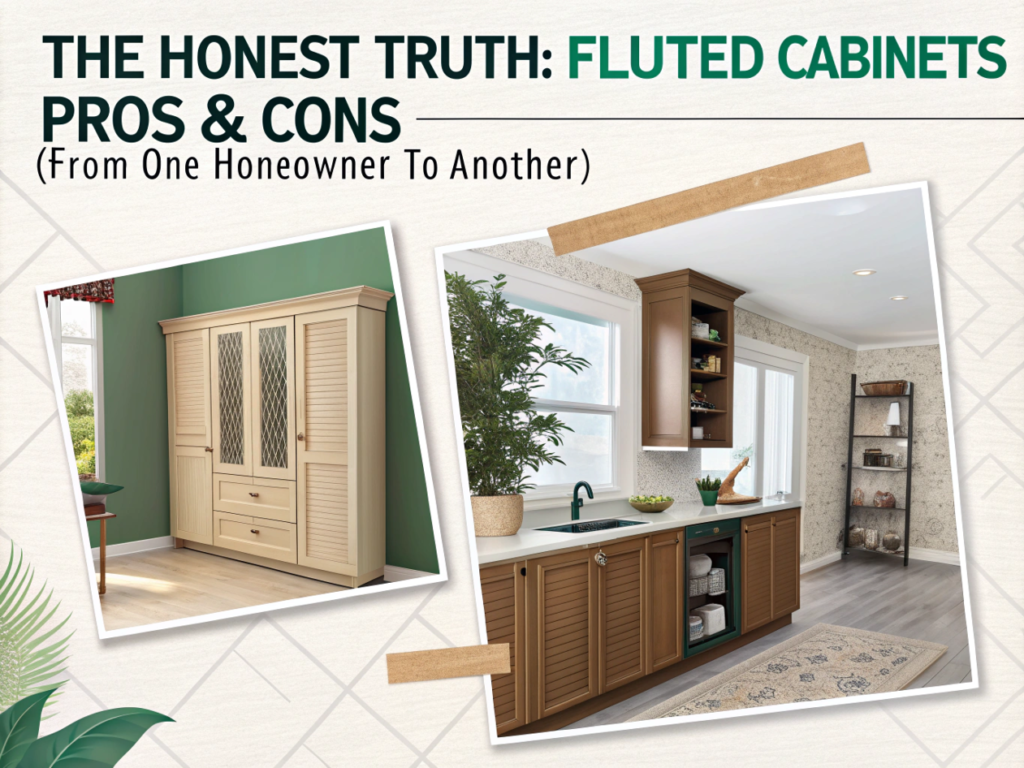
Let’s keep it real, fluted cabinets are beautiful, but they’re not magic. As someone who’s sanded more grooves than I can count (some of which I later regretted), I want you to have the full picture , not just the Pinterest version.
✅ The Good Stuff
- Warmth without clutter: Texture adds interest without needing extra accessories or visual noise. Even a neutral kitchen feels layered and finished.
- Forgiving to fingerprints: If you’ve got kids, housemates, or your own occasional chaos, fluted panels hide the daily smudges better than gloss or flat paint.
- Makes stock cabinets look custom: A fluted MDF panel can make an IKEA base cabinet look like it came from a boutique design studio.
- Adds “soft drama”: It’s subtle, like the cabinet equivalent of wearing linen pants instead of jeans. Relaxed but elevated.
⚠️ The Not-So-Great Bits
- Dust and grime do settle in: Those grooves? They’re cozy little homes for flour, crumbs, and mystery gunk. You’ll need to clean with a soft brush or vacuum attachment now and then.
- DIY takes precision: If you’re applying fluted panels yourself, uneven spacing or misaligned grooves can make a mess fast. Measure twice. Or three times.
- Can overpower small spaces if overused: A whole kitchen of deep grooves might feel like living inside a corduroy blazer. Use as an accent unless you’re sure.
What Materials Are Best for Fluted Cabinets
MDF is the budget go-to, smooth, paintable, and easy to groove. Real wood gives texture extra depth, but can warp if not sealed right. Laminate options exist too, but they can look a bit plasticky unless you go high-end.
DIY & Budget Tips, From Maya’s Toolbox

I’ll be straight with you: fluted cabinets look expensive, but they don’t have to be. I’ve done a full kitchen front refresh with less than €250, a handheld router, and more stubbornness than skill. If you’re even a little handy, you’ve got options.
Budget-Friendly Materials to Start With
- MDF (Medium-Density Fiberboard): The MVP of fluted fronts. Smooth, affordable, and takes paint beautifully.
- Pine or Poplar: Softer woods that groove easily if you’re routing by hand. Ideal for open shelving or small projects.
- Pre-fluted panels: Available online or at specialty DIY stores, you can cut and mount them directly onto cabinet faces like oversized stickers (but better).
DIY, How I Did My First Fluted Island
- Bought plain MDF drawer fronts, from a big box store.
- Measured + marked every 2 cm for consistent grooves.
- Used a trim router with a round-nose bit to carve the flutes. Took a weekend and a playlist.
- Primed and painted in a warm off-white.
- Mounted soft brass handles and called it a day (after ice cream).
💡 Pro Tips for a Cleaner DIY Job
- Always sand inside the grooves, it’s tedious, but worth it.
- Don’t go too deep. Grooves over 5mm can chip easily if not sealed.
- Use painter’s tape as a groove guide if you’re nervous about spacing.
Can You Add Fluted Panels to Existing Cabinets?
Yes! If your current cabinets have flat doors, you can add fluted panels or trim directly onto them with adhesive and a little patience. Just make sure your hinges can handle the added depth.
3 Real Style Ideas to Bring Fluted Cabinets Home (Without Overthinking It)
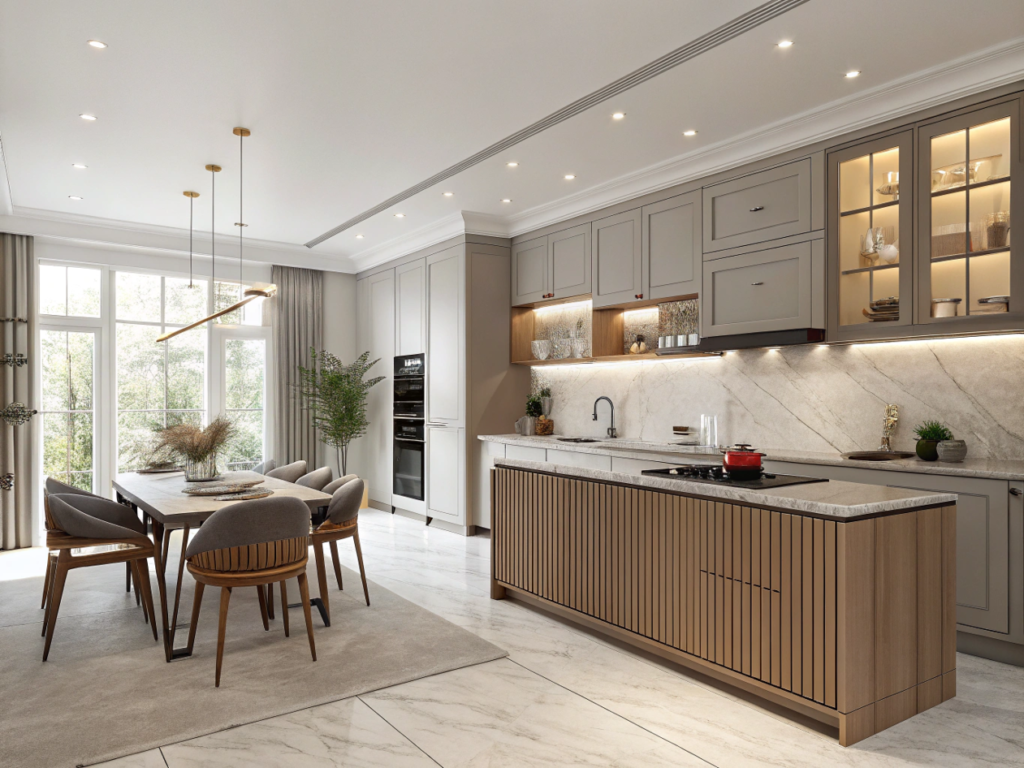
Fluted cabinetry doesn’t need to be a full remodel. In fact, some of the best uses I’ve seen, and done, are in small doses. Think of it like eyeliner: subtle can be stunning.
1. The Island Statement
Let your kitchen island be the rebel. Fluting it adds instant visual interest, especially in an otherwise simple space. I once added vertical grooves to an old butcher-block island, painted it forest green, and paired it with matte black handles. The result? People think the whole kitchen was custom-built.
2. Scandi Meets Grandma
Light oak tones, minimal hardware, fluted open shelves. It’s clean, calm, and feels like a hug. If you’ve got older cabinet carcasses, consider just replacing the upper doors with fluted versions instant brightness without the full overhaul.
3. Glam With Grit
Fluted cabinet fronts in deep navy or charcoal + brass pulls + marble-look countertops = chef’s kiss. It’s vintage Paris meets downtown loft. Bonus: darker grooves hide even more wear.
Design Pairings That Work
- Counters: Smooth quartz, butcher block, or matte granite
- Handles: Brass, matte black, or even leather pulls
- Backsplashes: Zellige tiles or vertical stacked subway
Can I Mix Fluted and Flat Cabinets?
Absolutely. In fact, it often looks better. Try fluted panels on base cabinets or an island and flat doors up top. It keeps things grounded without overwhelming the eye.
Fluted Cabinets FAQ, What People Are Really Asking (And What I’ve Learned)
When I first looked into fluted panels, I had about 17 tabs open and zero patience. So here’s a straight-talking roundup of what homeowners like you are actually Googling, and the honest answers.
Are Fluted Cabinets Hard to Clean?
Not really, just different. You’ll want a soft-bristle brush or vacuum nozzle to get into the grooves once in a while. I do a quick dust swipe once a week and a deeper clean every month. Totally manageable.
How Much Do Fluted Cabinets Cost?
Depends how you do it.
- DIY panels: €30–€60 per door (materials only)
- Custom fluted cabinetry: €150–€300+ per door
- Retrofit fluted trims: €10–€25 per linear foot
Budget tip: Start with one feature (like an island or pantry) before committing kitchen-wide.
Are They Going Out of Style Soon?
Nope, not anytime soon. Fluted textures have been around in furniture and architecture for decades. Kitchens are just now catching up. And when done subtly, it won’t feel dated five years from now.
Do They Make a Kitchen Look Bigger or Smaller?
Bigger, if done right. Vertical grooves draw the eye upward, just don’t go too dark or too deep in a tight space. Mid-sized flutes in soft tones are your best friend here.
What Is the Next Trend for Kitchen Cabinets?
While fluted cabinets are still riding high, the next big wave is all about mixed materials and personalized contrast, think walnut cabinets with woven cane inserts, or pairing sleek high-gloss uppers with matte textured lowers. The future of cabinetry isn’t one look, it’s layered, story-driven, and unapologetically you.
Are Reeded Cabinets Trendy?
Very much so, reeded designs (tighter grooves than fluted) are part of the same texture-loving movement. They offer a slightly bolder, more modern edge, and you’ll find them popping up on bar fronts, sideboards, and even bathroom vanities. If fluted feels too soft for your taste, reeded might hit that sweet spot.
Are Fluted Cabinets in Style?
100%. In fact, they’re not just in style, they’re becoming the go-to choice for adding warmth and personality without going full maximalist. Their staying power lies in their subtlety: they’re tactile, timeless, and quietly elegant, making them a smart long-term choice even beyond the current trend cycle.
Final Thoughts, Why Texture Might Be the One Upgrade Your Kitchen Needs
Here’s what I’ve learned sanding, routing, and daydreaming my way through more cabinets than I care to count: texture changes everything. A fluted panel isn’t just pretty, it makes your kitchen feel handmade, grounded, alive.
Whether you’re deep in a reno or just craving a change, fluted cabinets are one of those rare design moves that hit all the sweet spots: budget-flexible, visually rich, and deeply satisfying to live with. You don’t need a showroom budget or a design degree, just a bit of curiosity and the guts to try.
If you’re on the fence, start small. A fluted pantry door. A DIY island. Even just a drawer front. Texture invites touch, and touch makes a house feel like home.

